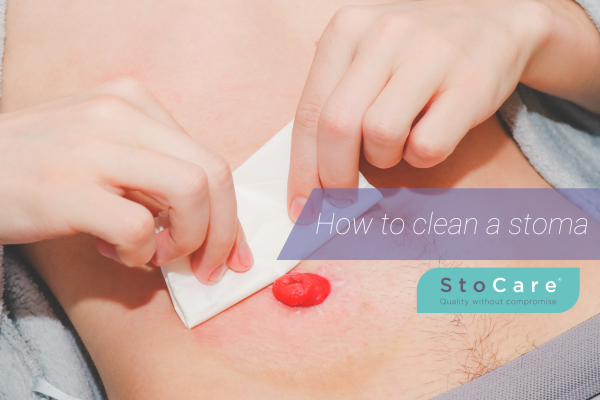A stoma can be life-changing, offering improved health and quality of life for many individuals. However, it can come with challenges. Understanding common stoma problems can make a significant difference in helping you to manage your stoma.
Below, we highlight 10 of the most common stoma issues, their causes and how to spot, prevent and manage them. We’ll also provide links to other helpful stoma resources so that you can read further about common problems with stomas.
Do you have a urostomy? We have a dedicated guide to urostomy problems which may be more relevant to you.
Click below to skip directly to the section you are looking for:
- Stoma skin irritation
- Stoma leakage problems
- Stoma blockage
- Stoma bag pancaking
- Stoma bag ballooning
- Stoma odour
- Parastomal hernias
- Retracted or prolapsed stomas
- Rectal discharge
- Mental health challenges
1. Stoma skin irritation
Skin irritation is one of the most common issues with stomas. This irritation can manifest as redness, itching, or even pain and bleeding. Irritated peristomal skin can quickly escalate to a skin infection if not treated.
Irritated skin increases the likelihood of your stoma appliance not fitting properly, leading to leaks and more skin irritation – it’s a vicious cycle. This is why it’s important to prevent this by using the right stoma products.
Common causes of stoma skin irritation
- Poorly fitted appliance
- Stoma leakage
- Sensitivity to adhesives
- Improper skin preparation
- Not removing adhesives gently
How to prevent and manage stoma skin irritation
- Use a barrier film in between bag changes to protect the skin.
- Ensure the appliance fits correctly.
- Use a medical adhesive remover when removing your appliance.
- Compare your peristomal skin to the skin on the other side of your abdomen to notice any changes.
- Treat any irritation that occurs quickly to prevent escalation.
Learn more: Peristomal skin protection
2. Stoma leakage problems
Stoma leaks can be distressing and, as we have already discussed, lead to stoma skin problems. While stoma leakage is a common stoma problem, it shouldn’t happen regularly and disrupt your everyday life.
Frequent stoma bag leaks indicate that you should reassess your stoma bag fit or care routine. Stomas change in size and shape over time, especially soon after surgery, so it’s important to be proactive to prevent stoma leakage as much as possible.
Common causes of stoma leakage
- Poorly fitting appliances
- Incorrect application
- Changes in stoma size/shape
- Change in diet or routine
- High or fluidic output
How to prevent stoma leakage
- Seek advice from a stoma care nurse for a refitting.
- Ensure you’re using the right products for your specific needs. For example, the Ostoform FLOWASSIST Seal has been specifically designed to prevent leaks even for high/fluidic output, irregular stomas or people struggling with sore skin.
- Take care of your peristomal skin.
Read more: Stoma leakage
3. Stoma blockage
A stoma blockage can occur when undigested food or adhesions (e.g. scar tissue) restrict the flow of waste through the stoma.
Symptoms may include cramping/tummy ache, swelling, less output than usual, or even no output at all for several hours. You may also experience nausea and vomiting. This can occur with both an ileostomy and colostomy but it’s easier to spot with an ileostomy because they are more active.
Common causes of stoma blockages
- High-fibre foods not digested properly
- Not chewing food properly
- Dehydration
- Adhesions
How to prevent stoma blockages
- Eat slowly
- Chew food thoroughly
- Stay hydrated
- Be mindful of high-risk foods like nuts, seeds, or fibrous vegetables. Read more: Foods to eat with a stoma
Some stoma blockages can be treated at home. Short walks, gently heating or massaging your abdominal area and eating/drinking liquids can help if you suspect you have a blockage. However, it’s important that you contact your stoma nurse or GP for advice if you suspect you have a bowel obstruction (especially if you have an ileostomy, as these are often more severe).
Read more: Stoma blockages

4. Stoma bag pancaking
Pancaking occurs when stool gets stuck at the top of the stoma bag instead of falling to the bottom. This can cause the stoma bag to collapse against the stoma, potentially leading to leaks or blockages. It’s often associated with thicker output and can make emptying the bag difficult.
Common causes of pancaking
- Insufficient airflow into the pouch, creating suction
- Thick or sticky stool consistency
- Lack of lubrication inside the pouch
- Parastomal hernias or retracted stomas
How to prevent pancaking
- Use a lubricant such as baby oil to prevent stool from sticking to the bag.
- Place a small amount of tissue or cotton wool inside the bag to allow airflow.
- Blow air into the pouch before application.
- Adjust your diet to soften output, including more water or fibre as recommended by a healthcare professional. Read more: Foods to eat with a stoma
- Try the Ostoform FLOWASSIST seal which has solved pancaking for some patients.
Our full guide to pancaking can be found here: Stoma pancaking
5. Stoma bag ballooning
Ballooning happens when gas accumulates inside the stoma bag, causing it to inflate like a balloon. This can lead to discomfort, odour release when emptying the bag, or even detachment of the appliance.
Common causes of ballooning
- Excessive gas production from certain foods or drinks
- Pouches without effective venting systems
- Blocked or malfunctioning filters in the stoma bag (this can happen if it gets wet)
How to prevent ballooning
- Choose stoma bags with advanced filter systems to release gas without odour.
- Avoid high gas-producing foods like beans, onions and carbonated drinks. Read more: Foods to eat with a stoma
- Eat slowly.
- Eat regularly and avoid going for a long time without food.
- Massage the pouch gently or “burp” it in a controlled manner to release trapped air if necessary.
Read our full guide to ballooning

6. Stoma odour
Concerns about stoma odour or excess gas can cause anxiety in social situations for ostomates. While most stoma bags are designed to control odour, improper sealing or certain foods can exacerbate the issue.
Common causes of stoma odour
- Stoma leakage
- Ballooning
- Poorly fitted appliance
How to prevent stoma odour
- Monitor dietary triggers of gas and tummy upsets.
- Find the right bag for you with an effective filter.
- Use deodorising drops, gels or sachets (available on prescription).
- Ensure a good seal on the appliance.
Read our full guide to stoma odour
7. Parastomal hernias
A parastomal hernia occurs when part of the bowel pushes through the abdominal muscles around the stoma. This condition can cause discomfort, bulging, or difficulties with appliance fitting. Although alarming, parastomal hernias are one of the most common stoma problems and rarely cause major complications.
Common causes of parastomal hernias
- Weakened abdominal muscles due to surgery
- Heavy lifting
- Weight gain
- Coughing or sneezing
- Infection at the site of the stoma
How to prevent parastomal hernias
- Start exercising slowly and gently after surgery.
- Avoid heavy lifting.
- Use a supportive belt for any strenuous activity.
- Maintain a healthy weight.
Find out more about parastomal hernias
8. Retracted or prolapsed stoma
Sometimes, a stoma can sink below the skin level (retracted) or extend further out than usual (prolapsed). Both conditions can complicate appliance fitting and stoma care, although they are usually nothing to worry about. Loop stomas are more likely to prolapse than end stomas.
Common causes of retracted or prolapsed stomas
- Problems during the formation of the stoma
- Weight gain
- Increased pressure on the abdomen, such as pregnancy or a tumour (prolapse)
- Excessive exertion (prolapse)
How to prevent and manage a retracted or prolapsed stoma
- Research specialist appliances, such as a convex bag or seal.
- Speak to your stoma care nurse who may suggest that you use a support garment.
- Very large prolapses may require surgery.
Read our full article about stoma prolapse

9. Rectal discharge
It is normal to experience some rectal discharge, even if you have a stoma. This will only happen if you have parts of your digestive system below the stoma still in place, such as if you had a Hartmann’s procedure or a loop stoma. The discharge could be made up of:
- Mucus
- Blood
- Faeces
- Pus
You may feel the urge to empty your bowels, or it may leak out without warning. The discharge is usually harmless and easily managed, but can cause problems if it is particularly persistent.
Read more in our full article on rectal discharge
10. Mental health challenges
Adapting to a stoma can be psychologically and emotionally challenging. Issues like body image concerns, anxiety, or depression are common, especially early in the adjustment process.
Causes of mental health problems in ostomates
- Sudden lifestyle changes
- Societal stigma or misunderstandings
- Personal adjustment difficulties in managing the stoma
- Anxiety about body changes and stoma problems like leaks or odour
Prevention and management of mental health problems in ostomates
- Seek support from stoma support groups. Find a stoma support group near you here
- Connect with fellow ostomates, for example via Colostomy UK or Urostomy Assocation‘s helplines and online groups.
- Be open and honest about your struggles with family and friends.
- Attend therapy or counselling.
- Speak to your stoma nurse about your feelings; they will signpost you in the right direction, which could be using different products or medical treatments.
Read more: Quality of life in stoma patients
Conclusion
Managing a stoma can feel overwhelming at times, but with the right knowledge and resources, many stoma issues can be effectively managed or prevented. Whether you’re dealing with stoma leaks, skin irritation or emotional challenges, remember help is always available. You are not alone and there is a great community of ostomates who understand what you are going through.
Explore more free stoma advice and support or connect with others via StoCare’s Instagram.
If you are a medical professional and are interested in finding out how StoCare products can help your patients or requesting a repeat sample order, please email info@rhodespharma.co.uk.
Although all our articles are written alongside qualified medical professionals, this information is for guidance only and does not replace advice given by your healthcare advisors.



